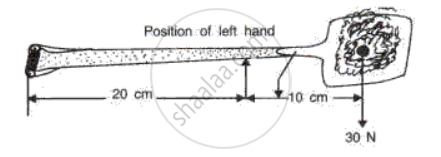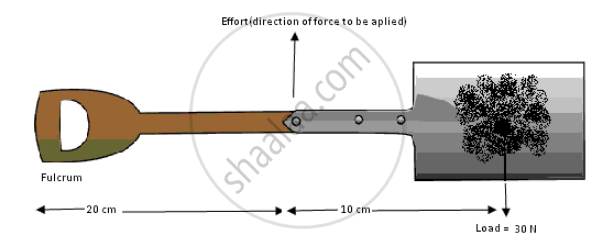Advertisements
Advertisements
Question
Fig. shows a spade. It is being used to lift soil weighing 30N from the ground.

(a) Mark the direction of the least force on the handle necessary to keep the spade balanced.
(b) Calculate the least force on the handle necessary to keep the spade balanced (the weight of the spade is negligible).
(c) If the left hand was move towards the soil on the spade, would the force on the handle necessary to keep the soil balance the greater or less? Give a reason for your answer.
(d) To which class of lever does the spade belong?
Solution
(a) Diagram showing the direction of application of least force on the handle:

(b) Given,load,L = 30 N
Let effort = E
Effort - arm = 20 cm
load - arm = 20 + 10 = 30 cm
Now, load x load - arm = effort x effort - arm
effort = `(30 xx 30)/20` = 45 N
(c) On moving the left hand towards the soil on the spade, the lenght of effort arm will increase and effort being inversely proportional to the lenght of effort arm, the force or effort necessary to keep the soil balanced would be less.
(d) A spade belongs to class III lever.
APPEARS IN
RELATED QUESTIONS
What do you understand by a machine?
What is the principle on which a machine works?
Name six simple machines. Give an example of each machine.
Answer the following in short.
Mention any two methods by which we can take care of machines.
The correct relationship between the mechanical advantage (M.A.), the velocity ratio (V.R.) and the efficiency (n) is ______.
Define Mechanical advantage
Give an example of the following use of a machine to change the point of application of the force.
A cook used a ‘fire tong pair’ of length 32 cm. to lift a piece of burning coal of mass 500 g. If he applies his effort at a distance of 8 cm from the fulcrum, what is his effort? Assume friction etc. to be absent. Also, obtain values of the M.A. and the V.R. of this ‘machine’.
What is a lever? How are the orders of the lever determined?
The idea of a simple machine originated with the Greek philosopher Archimedes.
